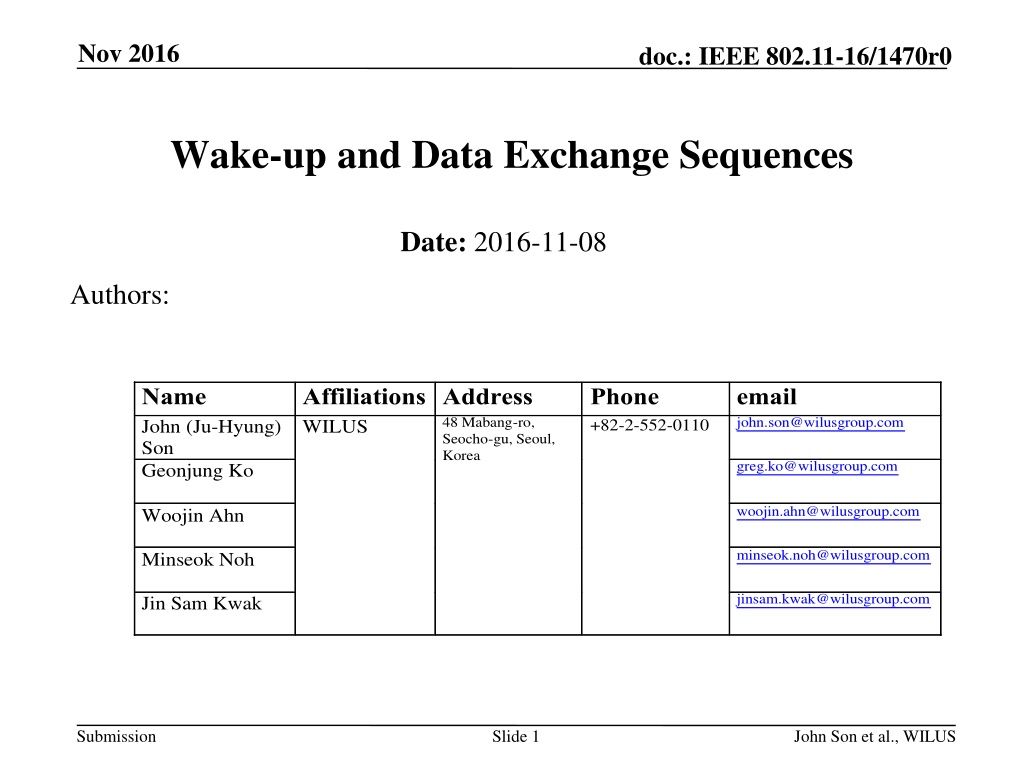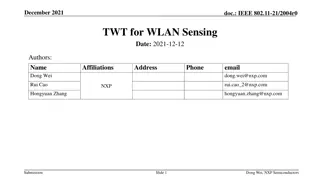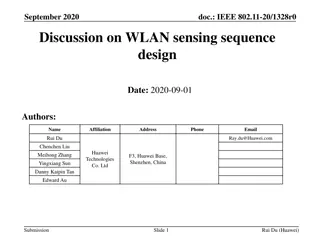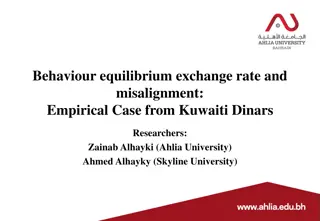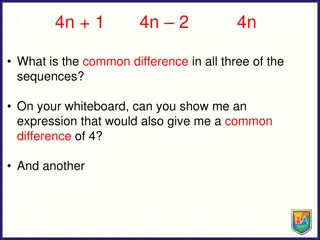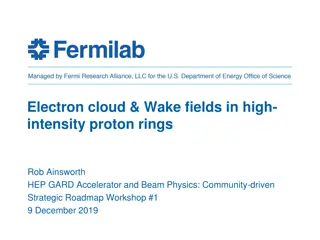Wake-up and Data Exchange Sequences
This document discusses Wake-up and Data Exchange Sequences in IEEE 802.11-16/1470r0 standard, focusing on reducing power consumption without compromising latency. It covers concepts like Wake-up packets, Backoff mechanisms, User Data Exchange, Wake-up Delay, Deep sleep states, and WUR sequences for efficient data transmission.
Download Presentation

Please find below an Image/Link to download the presentation.
The content on the website is provided AS IS for your information and personal use only. It may not be sold, licensed, or shared on other websites without obtaining consent from the author.If you encounter any issues during the download, it is possible that the publisher has removed the file from their server.
You are allowed to download the files provided on this website for personal or commercial use, subject to the condition that they are used lawfully. All files are the property of their respective owners.
The content on the website is provided AS IS for your information and personal use only. It may not be sold, licensed, or shared on other websites without obtaining consent from the author.
E N D
Presentation Transcript
Nov 2016 doc.: IEEE 802.11-16/1470r0 Wake-up and Data Exchange Sequences Date: 2016-11-08 Authors: Name John (Ju-Hyung) Son Geonjung Ko Affiliations Address WILUS Phone +82-2-552-0110 email john.son@wilusgroup.com 48 Mabang-ro, Seocho-gu, Seoul, Korea greg.ko@wilusgroup.com woojin.ahn@wilusgroup.com Woojin Ahn minseok.noh@wilusgroup.com Minseok Noh jinsam.kwak@wilusgroup.com Jin Sam Kwak Submission Slide 1 John Son et al., WILUS
Nov 2016 doc.: IEEE 802.11-16/1470r0 Introduction Wake-up packet Backoff 802.11 User Data Exchange WUR wake-up signal Wake-up Delay 802.11 Deep sleep Deep sleep In WUR PAR proposal [1], requirements for latency is defined In scenarios where low latency is a requirement, the WUR should decrease overall power consumption of the STA without significant increase in latency (relative to the current maximum latency of the nominal duration of one beacon interval, 102.4 ms) in transferring user data packets. Typical WUR sequence would be composed of Wake-up packet reception Wake-up delay (internal power state transition time of 802.11 transceiver) 802.11 User Data exchange In this submission, we discuss several WUR sequences comparing the recovery latency after the failed wake-up packet transmission Submission Slide 2 John Son et al., WILUS
Nov 2016 doc.: IEEE 802.11-16/1470r0 Wake-up delay defined in 11ax Awake State Transmit Receive Power Transition parameters Transition Time State Transitions Sleep State* Shallow Sleep Listen Deep Sleep 0.5 ms 10 ms Listen Shallow Sleep Listen Deep Sleep Sleep States and their Transition times defined in 11ax simulation scenario [2] Shallow Sleep power state of a wireless module is defined as a sleep state with baseband and MAC processors turned on, but RF is switched off. Deep Sleep power state of a wireless module is defined as a sleep state with the wireless radio turned off, i.e., RF, baseband and MAC processors are all switched off. The only power consumed by the wireless module is leakage power. WUR-based sleep state would be similar to the Deep sleep state minimizing power consumption We can assume the wake-up delay (sleep to listen state transition time) would be several milliseconds Submission Slide 3 John Son et al., WILUS
Nov 2016 doc.: IEEE 802.11-16/1470r0 WUR sequence 1 : DL Data DL Data Wake-up packet Backoff Backoff 802.11 WUR Ack wake-up signal Wake-up Delay 802.11 Deep sleep indicator for the successful WUP transmission WUR sequence AP transmits wake-up packet to WUR STA After STA s wake-up delay, AP transmits downlink data to STA Recovery from the failed WUP If the first data transmission is not acknowledged, AP should assume the previous wake-up packet transmission was failed AP should retransmit the wake-up packet Latency The failed wake-up packet transmission is indicated only after Wake-up delay + Channel access + DL Data + SIFS Submission Slide 4 John Son et al., WILUS
Nov 2016 doc.: IEEE 802.11-16/1470r0 WUR sequence 2: UL Poll DL Data Ack Wake-up packet Backoff Backoff 802.11 WUR Poll Ack wake-up signal Wake-up Delay Backoff 802.11 Deep sleep Timeout indicator for the successful WUP transmission WUR sequence AP transmits wake-up packet to WUR STA After STA s wake-up delay, STA transmits uplink Poll to AP AP transmits downlink data to STA Recovery from the failed WUP If AP does not receive the uplink Poll within a timeout period, AP should retransmit the wake-up packet Latency The failed wake-up packet transmission is indicated only after Timeout = Wake-up delay + Channel access + UL Poll + (some margin) Submission Slide 5 John Son et al., WILUS
Nov 2016 doc.: IEEE 802.11-16/1470r0 WUR sequence 3: WUR Ack WUR DL Data Wake-up packet Backoff Backoff 802.11 WUR Ack WUR Ack wake-up signal Wake-up Delay 802.11 Deep sleep indicator for the successful WUP transmission WUR sequence AP transmits wake-up packet to WUR STA STA responses with WUR Ack After STA s wake-up delay, AP transmits downlink data to STA Recovery from the failed WUP If AP does not receive the WUR Ack, AP should retransmit the wake-up packet Latency The failed wake-up packet transmission is indicated after SIFS Discussions STA s wake-up radio should have capability to send WUR Ack packet AP s WUR or 802.11 should have capability to receive WUR Ack packet WUR Ack packet may not have legacy preamble Submission Slide 6 John Son et al., WILUS
Nov 2016 doc.: IEEE 802.11-16/1470r0 Recovery from Wake-up packet failures Wake-up Packet Transmission 802.11 Data Exchange wake-up delay Late Immediate Recovery Procedure Recovery Procedure The wake-up delay (internal state transition time) can be quite large, i.e. several milliseconds, considering the current 802.11 transceiver implementations After the failed wake-up packet transmission, it d be better to have immediate recovery sequence to minimize the overall data delivery latency Submission Slide 7 John Son et al., WILUS
Nov 2016 doc.: IEEE 802.11-16/1470r0 Conclusions For low latency required scenarios, WUR sequence design should minimize the overall latency in transferring user data to STA We discussed several wake-up and data exchange sequences, and compared their recovery latencies when wake-up packet transmission is failed Due to the long wake-up delay, we propose that WUR design should consider an immediate acknowledgement mechanism after wake-up packet reception Submission Slide 8 John Son et al., WILUS
Nov 2016 doc.: IEEE 802.11-16/1470r0 References [1] 11-16/1045r6, A Par Proposal for Wake-up Radio [2] 11-14/0980r16, TGax Simulation Scenarios [3] 11-16/0341r0, LP-WUR (Low-Power Wake-Up Receiver) Follow-Up Submission Slide 9 John Son et al., WILUS
